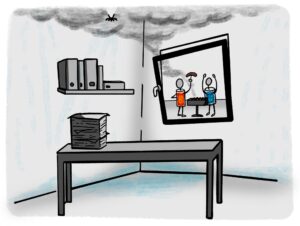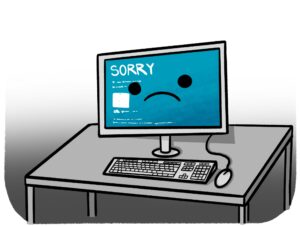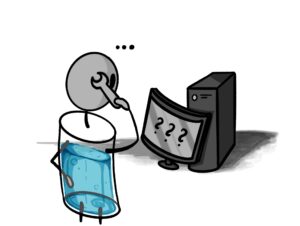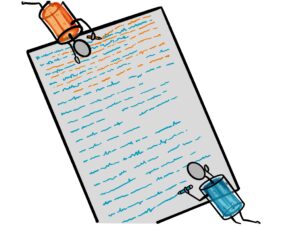All cases are real-life verified & foolproof.

1. Your external device gets lost or stolen!
USB sticks are small, and notebooks are attractive targets for thiefs. You better have a backup on a server!

2. Your hard disc drive crashes—quietly, but completely
Funders often demand ten years of data storage, but many drive vendors offer only a 5-year warranty. If you do the math, you’ll see the gap. You better have a backup on a server!

3. You can’t read or understand your own notes from three years ago.
Unclear handwriting, missing details, or poor organization will never happen to you and might not seem like a problem at first, but over time, they can make it difficult to find or understand even your own data. Electronic lab notebooks (ELNs) help with organization, save all details, and offer automated metadata.

4. Smoke triggers the sprinkler in your lab. Your lab notebook pages have become an inseparable mess.
Paper is not a reliable storage medium. It can burn or become water-damaged. Tools like ELNs help you organize your lab work digitally.

5. A new Ph.D. student discovers their predecessor has taken the data with them.
When researchers leave, their data may be inaccessible or poorly transferred. Encrypted files or accounts can become inaccessible without proper credential management.

6. Your PC is hijacked by ransomware.
The days when pimply-faced hackers deleted other people’s data are over. Today, malicious hackers encrypt other people’s data to extort ransom money. The only chance to recover your data is to pay, or—better yet—have a current backup.

7. When switching to new hardware, old data can no longer be read.
Your data may be safely backed up on a 5 1/4″ floppy disk—until you realize the PC with the drive no longer exists. It’s funny until you face the same problem with newer yet outdated storage. IT centers (at your institute) or cloud vendors ensure that data is always stored on up-to-date media.

8. Somebody in your team deletes or overwrites data.
To err is human. And even deliberate deletion happened. Suing someone doesn’t bring your data back.
Data management plans help to give everybody in the team the fitting role and right, and schedule backups to help restoring lost data.

9. You realize that you have been working with outdated versions of a dataset.
Are softwares backwards compatible and conflict-free? Usually, but not always. When you realise this, it’s too late.
Many ELNs have device interfaces that import the raw data. This allows them to be saved permanently alongside other experimental data.

10. Your spreadsheet reformats all the data on the sheet.
What was intended as a tool may end up changing your data permanently and irreversibly. It is better to make a copy of all the raw data before opening it in a spreadsheet.
You probably guessed it:
Great science starts with great documentation.
So, what can you do to ensure you’re well-prepared?
🟦 Create a Data Management Plan that defines folder structures, data backups, and team behavior.
For example, use the NFDI4Chem Data management plan (DMP) template.
🟦 Follow the 3-2-1 Rule: 3 backups on 2 different data carriers, 1 of which is stored externally.
🟦 Use an Electronic Lab Notebook (ELN): An ELN helps prevent data loss by securely storing, organizing, and backing up research records. Unlike traditional paper notebooks or scattered digital files, an ELN ensures that all information is traceable, accessible, and protected from physical damage, accidental deletion, or misplaced records.
- Documentation: ELNs record metadata (e.g., time stamps, experiment parameters), making it easy to track experiments, results, and changes over time. This ensures data is properly categorized and easily retrievable.
- Backups: Data can be regularly backed up, reducing the risk of accidental loss or hardware failure.
- Collaboration: Teams can access and share data seamlessly, reducing duplication of work and making project handovers more efficient.
- Repository: Completed research can be backed up in repositories, keeping it protected and readily available for publication or future reference.
“In the past, taking over a project meant going on a treasure hunt for data. Where are the lab books? What shelf, what page? Even after finding the right entry, tracking down associated files and samples could take hours—if they were found at all.
Now imagine losing seven months of work because critical data was misplaced. Redoing experiments, correcting errors, and wasting valuable resources—all because information wasn’t properly documented.”
—John Jolliffe, interview “The Chemistry Workflow of the Future”
Organize yourself and your research group—no more lost notebooks, redundant experiments, or wasted time. NFDI4Chem, Germany’s National Research Data Infrastructure for Chemistry, supports (Findable, Accessible, Interoperable, and Reusable) research data management with digital tools, standards, and electronic lab notebooks (ELNs), offering free resources and guidance for chemists.
The Author
Theo Bender is the Communications Manager at NFDI4Chem and works every day to make the world a little bit better by publicizing the great tools from NFDI4Chem.
Annalisa Riedel is a graphic designer who created the graphics (CC-BY-NC license) in this article.
Also of Interest

Spotlight: The Chemistry Workflow of the Future
John Jolliffe, NFDI4Chem, on good research data management for chemists, electronic lab notebooks, their scientific benefits, and scientists’ fears





